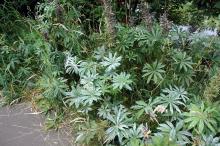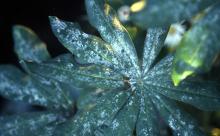Cause Although the fungus Erysiphe polygoni has been reported from all PNW states, molecular evidence indicates the presence of E. lupine and E. intermedia in Washington and likely the rest of the PNW. Can be prevalent in garden situations. It is favored by conditions that produce high humidity but dry leaves such as heavily-shaded growing sites. The fungus is a highly specialized pathogen that forms a close association with the host. Conditions that favor the host also favor the pathogen. Much of the fungus remains outside infected plant parts where it grows on the surface but sinks root-like structures called haustoria into plant cells to obtain nutrients. The white growth seen is composed of both mycelium and spores of the fungus. Cleistothecia are formed when isolates of different mating types occur on the same leaf. These fruiting bodies overwinter and release ascospores in the spring.
Symptoms White powdery spots that may quickly cover the entire leaf. Lesions may occur on widely scattered plants early in the season but can be almost uniform on heavily infected plants by late summer. Small black dots (cleistothecia) may be seen later in the white areas.
Cultural control
- Space plants for good air circulation.
Chemical control Fungicides will do best when used before symptoms develop. Few materials have good eradicant activity. Use at 7- to 14-day intervals; using shorter intervals when environmental conditions favor disease development. Alternate or tank-mix products from different groups that have different modes of action. Limit the use of any one group during crop production.
Ornamental materials:
- Broadform at 4 to 8 fl oz/100 gal water. Group 7 + 11 fungicide. 12-hr reentry.
- Compass 50 WDG at 1 to 2 oz/100 gal water. Do not use organosilicate additives. Group 11 fungicide. 12-hr reentry.
- Disarm 480 SC at 1 to 4 fl oz/100 gal water. Group 11 fungicide. 12-hr reentry.
- Insignia at SC 3 to 6 fl oz/100 gal water. Do not use with organosilicate-based adjuvants. Use preventively only. Group 11 fungicide. 12-hr reentry.
- Fame SC at 1 to 4 fl oz/100 gal water. Group 11 fungicide. 12-hr reentry.
- Although not specifically registered for lupine, products such as Heritage are safe on this crop, according to IR-4 data. These products provide good control of powdery mildew on many other crops. Group 11 fungicide. 4-hr reentry.
- Ortho Rose & Flower Disease Control at 2 fl oz/gal water. Group 3 fungicide. H
- Seido at 4 to 5 fl oz/100 gal water plus an adjuvant. Group 50 fungicide. 4-hr reentry.
Field Crop materials:
- Aproach at 6 to 12 fl oz/A. Preharvest interval is 14 days for pods, 0 day for forage and hay. 12-hr reentry.
- Aprovia Top at 10.5 to 11 fl oz/A on 7- to 14-day intervals. Preharvest interval is 14 days. Group 7 + 3 fungicide. 12-hr reentry.
- Endura at 6 to 11 oz/A. Preharvest interval is 7 or 21 days depending on crop. Group 7 fungicide. 12-hr reentry.
- Fontelis at 14 to 20 fl oz/A. Check label for preharvest restrictions. Group 7 fungicide. 12-hr reentry.
- Kenja 400 SC at 17 fl oz/A. Preharvest interval is variable depending on crop. Group 7 fungicide. 12-hr reentry.
- Headline at 6 to 9 fl oz/A. Preharvest interval is 21 days. 12-hr reentry.
- Luna Sensation at 4.8 to 6.8 fl oz/A. Do not use within 14 days of harvest. Group 7 + 11 fungicide. 12-hr reentry.
- Miravis Top at 9 to 14 fl oz/A. Do not use within 14 days of harvest. Group 3 + 7 fungicide. 12-hr reentry.
Reference Bradshaw, M., Braun, U., Götz, M. and Jurick ΙΙ, W. 2022. Phylogeny and taxonomy of powdery mildew caused by Erysiphe species on Lupinus hosts. Mycologia, 114:76-88, DOI: 10.1080/00275514.2021.1973287.



